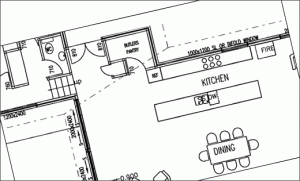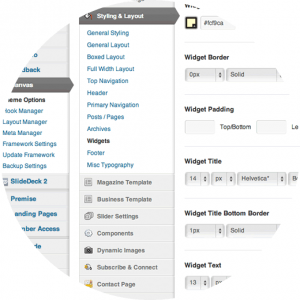We recently designed and built our own home. It was an incredible learning experience, and one which regularly reminded me of the process I undertake with clients when designing their websites.
Approaches to finding a new home and their web design equivalents include the following:
1. The Architectural Approach
 When first met with an architect, we expected to hand over a wishlist of preferences for our new home such as the number of bedrooms and bathrooms we wanted and then thought that he would figure out a good way to put everything together on the land we had. We were wrong! One of the first things which the architect asked us was “How do you live? Tell me about a typical day and a typical week in your house.” At first blush, it seemed a strange question but made complete sense when we stopped and considered it: the key practicalities of our family’s life was more important for him to distill than what we thought we needed or wanted. He would use that information, along with our wishlist, to consider how to design the best house for us.
When first met with an architect, we expected to hand over a wishlist of preferences for our new home such as the number of bedrooms and bathrooms we wanted and then thought that he would figure out a good way to put everything together on the land we had. We were wrong! One of the first things which the architect asked us was “How do you live? Tell me about a typical day and a typical week in your house.” At first blush, it seemed a strange question but made complete sense when we stopped and considered it: the key practicalities of our family’s life was more important for him to distill than what we thought we needed or wanted. He would use that information, along with our wishlist, to consider how to design the best house for us.
Working with a web designer is similar: you benefit from their expertise and experience, trusting them to learn about your site and its content, your vision for it, goals and wish list. They’ll suggest approaches you may not have considered and question some of the things you thought were important to distill what really is required. You’ll need to be prepared to discuss ideas and test assumptions, rather than rush to the end result. It’s a lot more than aesthetics.
To go down the architectural route means a larger initial investment of your money and time. The result is a tailor-made solution which both suits your needs and inspires you. Aesthetically it’ll look original, your content will be showcased in the best way possible and visitors will easily be able to achieve their goals.
2. The DIY approach
 We never seriously considered the option of buying an older existing house and renovating it ourselves. With my husband and I both running our own businesses, and littlies, the thought of dedicating all our spare time and energy to stripping walls, sanding floors and living with half-finished projects was too exhausting. For others, this option has its obvious drawcards: less up-front expense and the ability to save on costs by working on things yourself. However, things generally take longer, are more stressful, and there can be unexpected costs. For example: when removing a wall, you may discover that hidden wiring is completely unprofessional and unreliable and needs to be redone.
We never seriously considered the option of buying an older existing house and renovating it ourselves. With my husband and I both running our own businesses, and littlies, the thought of dedicating all our spare time and energy to stripping walls, sanding floors and living with half-finished projects was too exhausting. For others, this option has its obvious drawcards: less up-front expense and the ability to save on costs by working on things yourself. However, things generally take longer, are more stressful, and there can be unexpected costs. For example: when removing a wall, you may discover that hidden wiring is completely unprofessional and unreliable and needs to be redone.
When taking the DIY approach, you’re always working from someone else’s starting point: a house which suited their lifestyle and tastes to try and make it suit your own. There’s inevitably compromises and sometimes the renovators can wonder if it would have been better starting again from scratch.
This process is akin to purchasing an inexpensive pre-existing generic website theme and then trying to adapt it to suit your own needs. The lure is that the initial cost and time to get your site up-and-running both appear low. In actuality, a considerable amount of time is spent looking for said theme and trying out multiple options before finding one which is a decent fit. Further time is spent configuring the theme and adapting it until you’re happy with it.
In reality, the design may look and sound wonderful on display, until you go and try to make it your own. You’re trusting the code beneath the surface is well-written and efficient and that there’s no hidden problems. Trying to make changes which may seem simple may require extensive, frustrating work to get it to do as you’d like. In fact, some themes have so many options that counter-intuitively they end up being very difficult to do anything but what they offer. Unless you’re a proficient coder, you may make changes which can have unintended consequences which prove costly over time to repair. Support for the theme can be non-existent (meaning it will take longer for an out support person to come in and diagnose problems) or slow and impersonal rather than having someone to personally contact when things go wrong.
A very common story
 Emily is a brand new blogger. She’s excited about finally getting going writing about her favorite passion: making creative, healthy school lunches for her kids. She’s heard WordPress is what bloggers prefer so buys a cheap hosting plan which comes with a free domain name and presses the WordPress install button her web host provides. In just a few minutes, she’s got her new website live.
Emily is a brand new blogger. She’s excited about finally getting going writing about her favorite passion: making creative, healthy school lunches for her kids. She’s heard WordPress is what bloggers prefer so buys a cheap hosting plan which comes with a free domain name and presses the WordPress install button her web host provides. In just a few minutes, she’s got her new website live.
She jumps right in to look for a new free generic theme. Emily doesn’t want to stick with the default theme which comes with WordPress – it feels as though there’s none of her personality and originality and doesn’t feel fun and kid-friendly which is the mood she wants to convey.
At first, the process of hunting for a new theme is exhilarating and exciting, but it quickly becomes a little overwhelming and time-consuming trying to find something she’s happy with. She starts off looking at WordPress.org’s set of generic themes, but detours off to Google to hunt for other free themes. She becomes frustrated and wonders where else she should be looking to find the perfect theme. She finally chooses a free theme, follows the instructions to install it, fills in the settings and options and then makes the theme active on her blog. Emily looks over the blog and isn’t happy. It doesn’t look like the demo of the theme. In fact, some of it looks really broken and she’s not sure why. She spends a few hours adjusting settings, moving things around and playing with fonts, colors and a new logo. At the end of a long night, Emily looks over the site and thinks that maybe she should start the hunt for a blog theme all over again when she has more energy.
The next time she has a hunt, she looks at a bunch of blogs she likes the designs of and tries to find out the theme names they’re using by looking in the footers or emailing the blogger. Many of the blogs don’t say the name of the theme, just a designer. A few mention a theme, which links off to where the theme can be downloaded for free or bought. Emily installs one of these – a free generic theme – and it seems to work this time. She spends hours adding in lots of widgets to the sidebars and footers and adjusting the logo, colours and fonts. Eventually, she’s pretty happy with her work.
It’s not long until she wonders if she could do a better job with the site’s design. There’s things she wants to do, but can’t figure out how to change these in the theme settings and she’s very worried about breaking things if she goes in and touches the code. In fact, the code looks like a foreign language to her and makes her feel quite anxious just looking at it. The person who made the free theme doesn’t offer support. She asks her friends if any of them can help with her blog. One friend has used WordPress before and helps her do a few things but some of them are too tricky for her friend to do. Emily feels frustrated that she doesn’t know code, that she feels limited by her theme in what she wants to do and isn’t sure what she should do next.
In the meantime, her blog continues to grow in traffic (particularly from Pinterest) and she’s getting some fantastic feedback from her readers. Jamie Oliver even retweets one of her posts. She’s had calls from reporters who want to feature her blog in stories they’re writing about healthy food options for kids. She’s invited onto a local TV show to demonstrate some of her ideas and is regularly asked if she’s planning on writing a book.
Emily now knows it’s essential for her to invest some money and time into getting a professional designer to redesign her site so that it is well-organized and professional. She needs a professional bio photo and a press kit.
Emily’s story is a typical scenario.
Closing thoughts
 One of the first things people start thinking about when starting a new blog is how it looks. WordPress comes with a default theme which works nicely out-of-the-box and can be somewhat customized. Irrespective of how beautiful and functional this default theme is, most bloggers tend not to stick with this theme as sticking with the generic theme may feel as though there’s no originality, personality, thought of or care being put into the blog. It can also feel as though it was set up automatically and is run by a spammer.
One of the first things people start thinking about when starting a new blog is how it looks. WordPress comes with a default theme which works nicely out-of-the-box and can be somewhat customized. Irrespective of how beautiful and functional this default theme is, most bloggers tend not to stick with this theme as sticking with the generic theme may feel as though there’s no originality, personality, thought of or care being put into the blog. It can also feel as though it was set up automatically and is run by a spammer.
There are thousands of free generic themes, paid generic themes, theme frameworks and designers who will customize a generic theme or design a tailor-made theme. It can be hard to know where to start looking as there is no one central repository for themes.
 Apart from the DIY renovation analogy, another analogy I find helpful with explaining generic blog themes is they’re a lot like seeing a gorgeous dress on a model in a shop window. It’s hard to tell how well it will fit you or suit you until you’ve tried it on; and it’s even harder to know how well it will wear, last and work practically until you’ve bought it and used it for a while. Some dresses seem like they’ll be easy to adjust, but aren’t. Some dresses work just fine. Some dresses date terribly. Some look amazing but the workmanship is shoddy and you end up with all sorts of dramas.
Apart from the DIY renovation analogy, another analogy I find helpful with explaining generic blog themes is they’re a lot like seeing a gorgeous dress on a model in a shop window. It’s hard to tell how well it will fit you or suit you until you’ve tried it on; and it’s even harder to know how well it will wear, last and work practically until you’ve bought it and used it for a while. Some dresses seem like they’ll be easy to adjust, but aren’t. Some dresses work just fine. Some dresses date terribly. Some look amazing but the workmanship is shoddy and you end up with all sorts of dramas.
Sometimes you just need a dress to wear that’s not going to be a big investment and will keep you going for now.
And then there’s the wedding dress – almost all women would get it tailored by a professional so they look their best on their big day. They don’t want to look like every other bride out there and don’t mind the investment they’re making.
Interested in talking to us about your website’s design?
Feel free to send us an email ([email protected]) or phone: +1 646 233 3046.
Get actionable tips to grow your website
Thoughtful weekly insights (no hype!) on improving your website